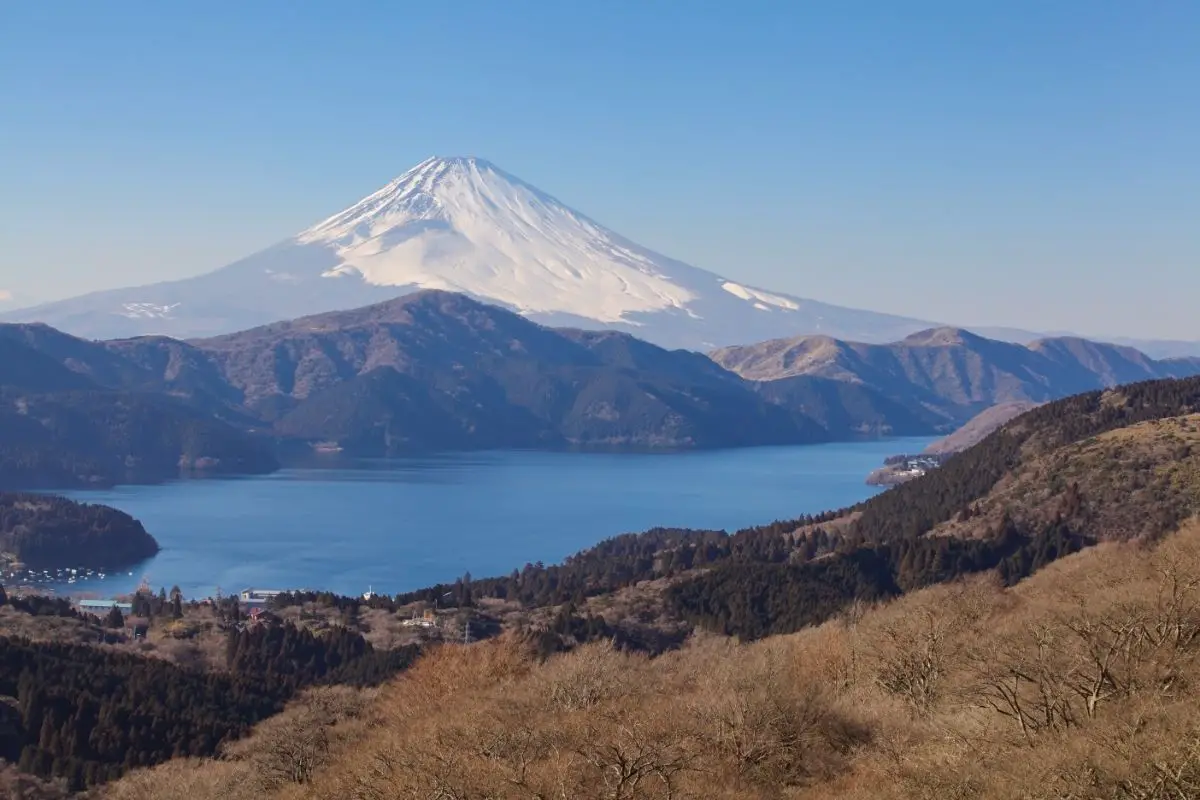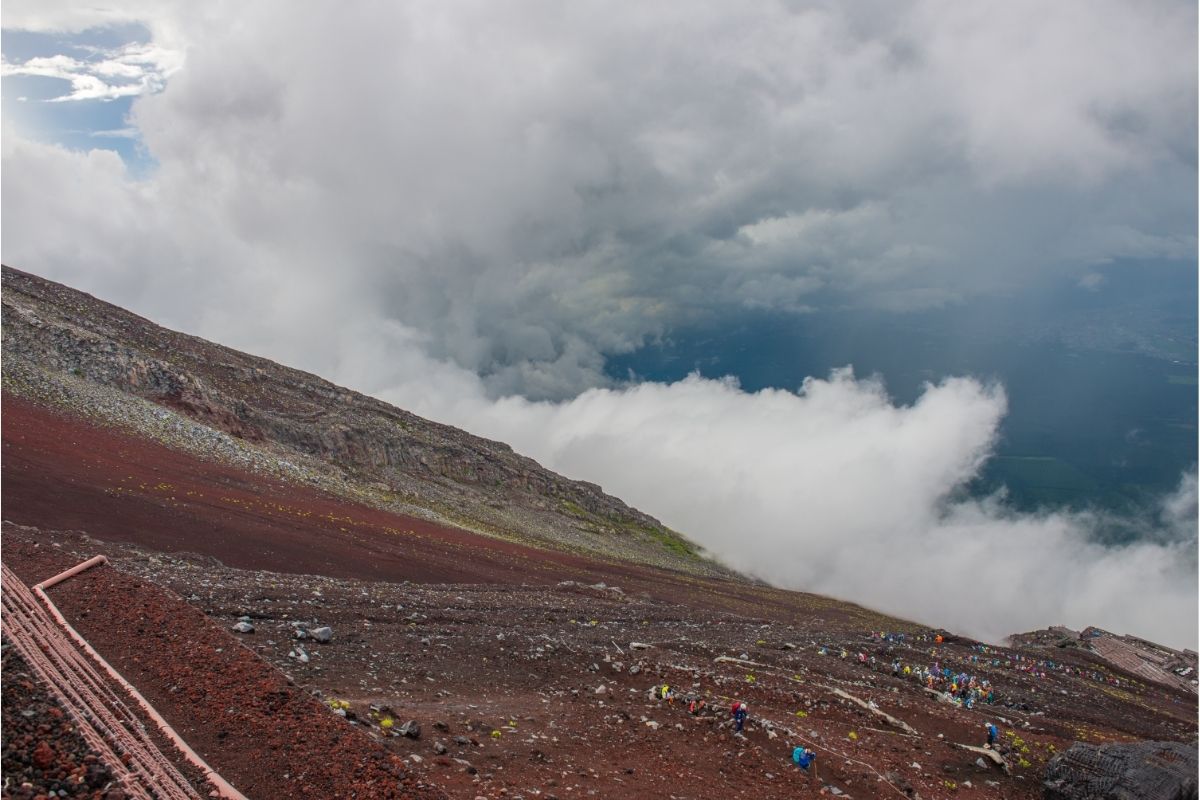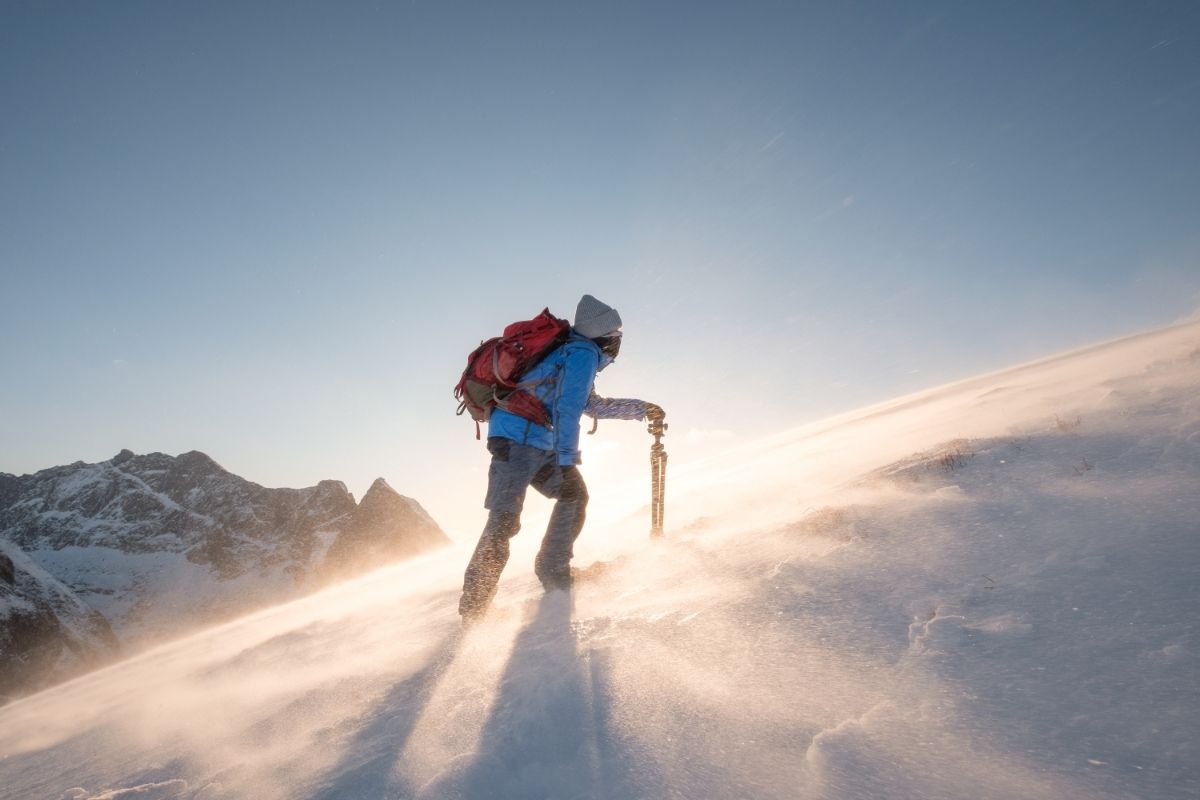Mount Fuji is one of the most famous images associated with Japan.
Mount Fuji stands 12,389 feet tall and it is located in the Fuji-Hakone-Izu National Park. It is an active stratovolcano and the second-tallest volcano on an island in Asia (see also, ‘What Hemisphere is Japan in?‘).

The famous symmetrical peak of Mount Fuji can be seen from Tokyo on a clear day and is famously white-capped for five months of the year.
As it is one of three sacred mountains in Japan women were forbidden to climb to the peak until the late 1860s.
The first foreigner to reach the summit was Sir Rutherford Alcock in September 1860, taking 8 hours to ascend and 3 hours to descend, and the first female foreigner, Lady Fanny Parkes, climbed the mountain 7 years later.
Since then safety restrictions have been put in place and the mountain is only open to climbers at certain times of the year.
Outside these months, the mountain is treacherous and climbing is forbidden. Nowadays more than 300,000 people climb the gorgeous mountain each year.
The brave climbers are mostly novices but many who climb Fuji return each year as part of a pilgrimage. For foreigners visiting Japan, climbing Mount Fuji is bucket-list-worthy.
Here we look at how to get to Mount Fuji, the logistics of climbing the mighty peak, and list what you will need to bring with you to safely ascend and descend the mountain.
Getting To Mount Fuji
There are lots of different ways that you can travel to Mount Fuji, it depends on where you are coming from. Below we look at how to get to Mount Fuji from three of the main cities in Japan, Tokyo, Kyoto, and Hiroshima.
Traveling To Mount Fuji From Tokyo
There are buses that go from Shinjuku in Tokyo (see also ‘Best Hotels In Shinjuku‘) straight to the Subaru Fifth Station on Mount Fuji.
These buses also stop at the base of the mountain so you can decide which part of the mountain you would like to begin your journey from but we highly recommend climbing from the fifth station as there is not a clear path from the base of the mountain which means it is not suitable for novice climbers or anyone unfamiliar with the area.
If you want to travel in style then you can take the shinkansen, or bullet train as they are often referred to, to Mount Fuji also.
Japanese Rail Train Stations surround the base of the mountain on the north and south sides and make traveling there very simple.
Decide on your starting point and arrange to get the bus or train to wherever this may be. There are buses that connect the train stations to the mountain.
Traveling To Mount Fuji From Kyoto
If you are traveling from Kyoto or Osaka you can get to Mount Fuji in a number of hours. We advise taking the Shinkansen to shorten your journey and also for simplifying your journey.
If you choose to travel by Japanese Rail you will need to make a number of changes and some of these changes will be short on time, as well as being in rural parts of the country where there may be fewer people that can speak English.
Buses are another option but the journey takes almost five hours and there are also changes required.
A great way of making this journey is by investing in a JR rail pass which can help you to save money on the often expensive shinkansen tickets.
JR rail passes must be purchased online before arriving in Japan and are usually posted to your home country.
If you are traveling on a budget the bus fare may suit you better but the JR pass will give you more options for your choice of transport to Mount Fuji from Kyoto.
Traveling To Mount Fuji From Hiroshima
Traveling to Mount Fuji from Hiroshima is also very easy to do as there are a number of trains and shinkansens that link this city with the famous mountain peak.
If you take any of these modes of transport you will be required to make transfers.
Similarly to traveling from Kyoto and Osaka if you have a JR pass we recommend traveling by shinkansen as this will be the fastest way to travel.
We don’t recommend traveling via bus as a bus from Hiroshima to Mount Fuji can take up to 12 hours with numerous transfers.
Regardless of where you are traveling, in most cases, the quickest mode of transport to travel to Mount Fuji from other destinations in Japan will be the shinkansen, but note that you will need to get a bus from your arrival station to the fifth station on Mount Fuji, or the base.
If you are staying on a different Japanese island, such as Hokkaido or Okinawa, we recommend flying (see also, ‘How Long is the Flight from Hawaii to Japan?‘) to Tokyo and taking a bus from Tokyo out to Mount Fuji.
The Hakone area, where Mount Fuji is, is absolutely stunning and if you love the great outdoors it would be worthwhile staying a few days to enjoy everything the area has to offer.
Climbing Mount Fuji

Now that you know how to get to Mount Fuji there are some things you need to know before you set out to climb the tall peak.
1. Time Of The Year
There is a specific climbing season for Mount Fuji and climbing is only permitted during this period.
July to September each year is deemed as the safest time to climb the mountain as it is warmer and drier than other months and local cafés and shops are also open during this advised climbing period giving you an opportunity to buy supplies and souvenirs.
Climbing outside this official hiking season is forbidden unless you are an experienced climber.
In the case of an experienced climber, you can apply for permission but you must be able to show that you have all the necessary equipment and submit a climbing plan that will need to be approved.
The government genuinely cares for the safety of people and that is why these safety measures have been put in place.
2. Climbing Routes
There are four trails that you can choose from when climbing Mount Fuji.
You will need to decide in advance which trail you are planning to hike as this will affect what station you need to arrive at if you are traveling via bus or train.
Each trail differs in difficulty and estimated hiking time (for more beautiful hiking trails, read here). Most of these trails begin from the 5th station.
Most buses from the base of the mountain will be able to bring you up to the 5th station so begin your journey up whatever trail you chose to follow.
The Yoshida Trail is the most popular trail as it provides a stunning view of Fuji Five Lakes at the starting point. Fujinomiya Trail is the shortest but it is also the steepest so it is not as easy as you would expect it to be.
The Subashiri Trail starts closer to the base of the mountain than others, meaning you need to hike through the forest at the start of your journey.
The longest and most difficult trail is the Gotemba Trail which is not recommended for inexperienced climbers.
There are cabins along the trail at each of the ten rest stations along the mountain that are suitable for overnight stays but you must book in advance due to the high numbers of people that climb overnight to watch the sunrise from the peak.
If you don’t get a space in a cabin you can bring a sleeping bag and sleep outdoors but be aware temperatures drop considerably after the sun goes down.
3. Check The Weather
To ensure you get the most out of the view Mount Fuji has to offer it is worthwhile checking the weather to ensure you will have clear, blue skies while you hike up Mount Fuji.
If you are planning an overnight hike dry weather is essential, especially if you are not staying in a cabin at one of the many rest stops. Wet weather makes the mountain extremely slippery and dangerous.
4. Altitude Sickness
If you are a first-time climber there is a chance you may be affected by altitude sickness. Altitude sickness is a reaction in your body as it is climbing up such a great height.
You may feel dizzy, nauseous, develop a headache or have some trouble breathing.
To prevent altitude sickness from affecting you it is important to rest at each of the 10 stations along the mountain to allow your body time to adjust to the elevation changes.
5. Carry Change For The Restrooms
There are restrooms along the mountain trail but these restrooms are not free. The small usage fee goes towards the difficult task of servicing these restrooms and fee’s become more expensive the higher up the mountain that you go.
What To Pack For Climbing Mount Fuji

There is one final thing that you need to consider before beginning your trek to the summit and that is what you need to pack and wear.
Below we have a list of what should be in your bag for both daytime and overnight hikes as well as outlining what you need specifically for the overnight hikes.
Hiking Boots
Mount Fuji has very uneven terrain and so decent boots are essential to prevent you from stumbling and landing on your bottom.
Warm Clothing
Layers are very important, the air will become cooler the higher you climb and warm clothing is especially important if you are spending the night on the mountainside
Water
Hydration is key, especially for avoiding dehydration and altitude sickness. 2 liters per person is recommended.
Food
High protein snacks, like energy bars and onigiri rice balls, are great as they are easy to carry and good for filling your belly.
Head Torch
For when things get dark, a head torch will keep your hands free to help scale the mountain while illuminating your path.
Sleeping Bag
If you are sleeping overnight on the mountain a sleeping bag is essential.
Sanitizing Or Baby Wipes
The perfect way to wash your hands after using the restroom without having to waste water. Also a great way of freshening up the next day.
Other luxuries that are not necessary but are nice to have are: cameras to take pictures, rain gear for any possible wet weather, a thermal foil blanket, and a small first aid kit
Remember you will need to carry whatever you bring up the mountain back down again so try to keep your backpack as light as possible.
Near the peak of the mountain, all trails become steeper so you will need to ensure you can keep your balance and a heavy bag has the possibility of making you unsteady and causing a potential accident.
There are no trash cans along the mountain so you will need to bring any trash you may have back down the mountain to dispose of properly.
Final Thoughts
If you take the time to research and prepare for climbing Mount Fuji. And if you are there at the right time of the year, then anyone that is fit to do so can climb Mount Fuji.
The views from the top of the mountain are beyond words and if you complete your descent as the sun is rising it’s like a look at heaven as you watch the skies illuminate below you and the world begin to stir.
You can find shops at the top of the mountain as well as a shrine to pray at and a post office to send postcards to your loved ones at home. Don’t forget to also check out the crater, Mount Fuji is a volcano after all!
Remember safety first and be aware of your surroundings at all times to make sure you can get both up and down the mountain safely with nothing but memories to last a lifetime.
- Transport in Japan: Exploring Buses, Public Transportation, Railways, Bicycles, and Major Cities - April 3, 2024
- Exploring Japan: Prefecture and Regions of Japan - April 3, 2024
- Travel Guide: Visiting Mount Koya (Koya, Mount Koya, Koyasan) – A Pilgrimage to the Spiritual Heart of Wakayama in Kansai, Japan - April 2, 2024








